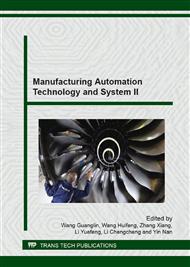p.392
p.400
p.407
p.413
p.419
p.425
p.431
p.437
p.443
Research on Tension Control System of Wire Saw Slicing Machine
Abstract:
Nowadays, wire sawing becomes the most advanced brittle crystals slicing technology because of its advantages of slicing larger crystals ingots into very small thickness, high surface quality, high yield wafers. In the process, the thin wire, which is the processing tools, travels at high speed, and subjects to external excitation from many aspects. Wire saw tension control is the core and difficulty of the control system. Mathematical models of tension subsystems were studied. The control strategy of swing arm motor tension direct closed-loop combination of speed difference indirect closed-loop was proposed. The developed tension control hardware and software system reached the functional requirements and technical indicators, and constant tension precision control was solved effectively.
Info:
Periodical:
Pages:
419-424
Citation:
Online since:
August 2014
Authors:
Price:
Сopyright:
© 2014 Trans Tech Publications Ltd. All Rights Reserved
Share:
Citation:


